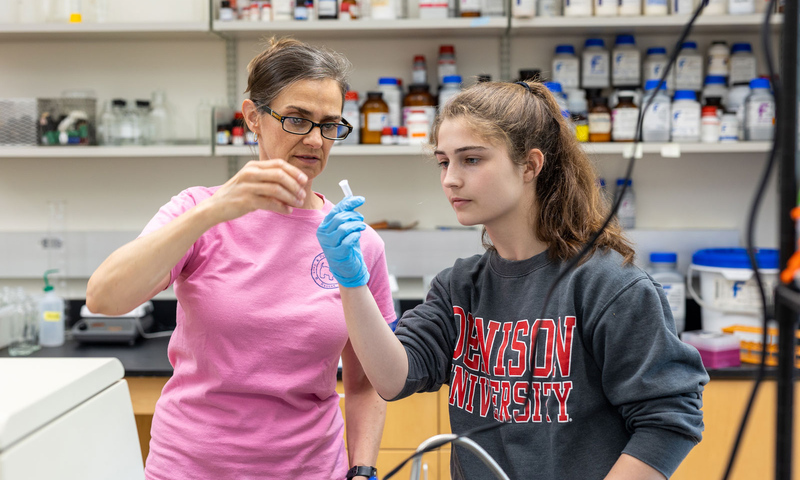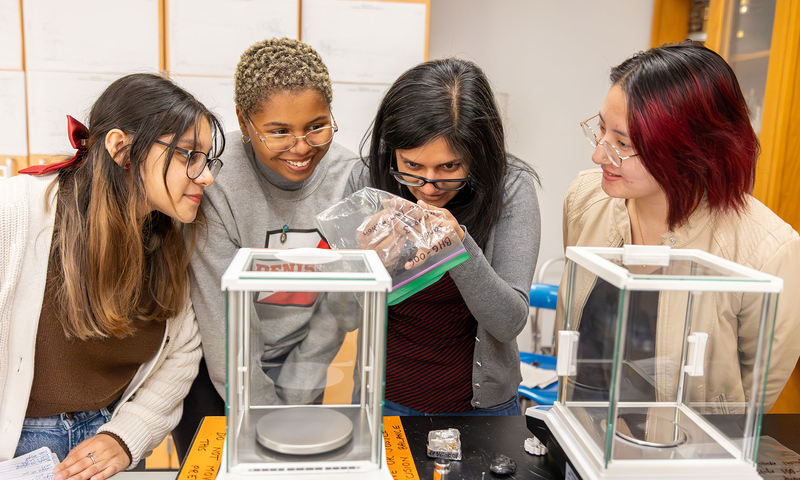Negative ions, atoms that have gained additional electrons, have many fascinating properties. Some claim they alleviate depression and anxiety, some claim they help clean the air, but for physics major Sarah Spielman ‘21, the attraction to negative ions has led to thought-provoking research, a summer project in Sweden, a co-authored paper published in the journal Physical Review A (possibly with more to come), and even a meeting with a winner of the 2019 Physics Nobel Prize, Dr. Donna Strickland.
“I have always loved science and learning how things work,” says Spielman, who was unsure of which science to study when she came to Denison. “Funnily enough, physics professor Dr. Wes Walter was my June-O advisor, and suggested I take physics. I actually did not enjoy high school physics, so I kind of begrudgingly agreed to give it a try. I took the first course in physics, and the rest was history.”
“I realized I just had the wrong picture of what physics was, and the fundamental ideas that governed things I was interested in (like atoms, or electrical circuits) could all be explained by physics,” she adds.
”What really solidified my interest in physics was that first summer of research after my freshman year with Dr. Walter and Dr. Dan Gibson—I had an absolute blast, and something just clicked—I found something I was incredibly passionate about, and I knew this is what I wanted to do.”
Walter notes, “Sarah’s a fast learner in the lab, she has outstanding hands-on technical skills, and she’s fiercely dedicated to doing science. She’s been able to contribute at increasingly deep levels to the research, including synthesizing, interpreting, and critically evaluating the results.”
Over her Denison career, Spielman has deeply researched four specific negative ions.
1. Thallium (as a first-year summer scholar):
“I focused on making a high precision measurement of the electron affinity, of which previous measurements had large discrepancies.” Spielman presented this research at the APS-DLS (American Physical Society Division of Laser Science) undergraduate symposium in Washington, D.C. In May 2020, after participating in additional analysis conducted over her sophomore and junior years, she also co-authored a paper on her thallium research, which was published in Physical Review A.
“The D.C. conference experience was incredible, as I got to sit at the same table as the 2019 Physics Nobel Prize Winner (and only the 3rd woman to do so!), Dr. Donna Strickland. It was incredibly inspiring, and it only re-enforced that this is what I am passionate about.”
2. Rhodium (in Sweden at the DESIREE facility):
Professors Wes Walter and Dan Gibson, were awarded a week of beamtime at the DESIREE (The Double ElectroStatic Ion Ring ExpEriment) facility at Stockholm University in Stockholm, Sweden, to study lifetimes of excited states of rhodium. Sarah and another Denison student researcher, Remington Ponce ’21, participated in these experiments in May 2019.
“DESIREE is a cryogenic ion storage ring (just one of 3 in operation worldwide). It was another incredible experience—not only in conducting the experiment itself, but also because I was able to collaborate and work with other graduate students from around the world on this project, and see what professors do when they collaborate with one another. Plus, I can’t complain about Swedish coffee, and their many coffee breaks!”
Walter relates an example of Sarah’s initiative: “As soon as she heard that Dan and I were planning to submit our first proposal for beamtime at DESIREE, Sarah immediately applied for a passport – if we got beamtime, she was darned sure going!”
3. Bismuth (in the Denison lab):
“We (think) we made the first observation of a particular type of excitation process. I cannot go into much detail about this as a paper is currently in the works this fall but keep an eye out for it hopefully in Physical Review Letters! Both Remington and I presented this research virtually at the APS-DLS undergraduate symposium.”
4. Lanthanum (in the Denison lab):
“The lanthanum project kicked off my senior research, of which I plan to do throughout the year and complete a Thesis with Distinction. In addition to conducting some additional experiments for my senior research, I am working on re-building a large portion of our experimental apparatus in order to include a collinear laser system.”
Graduate school is in Spielman’s future, mostly likely to pursue a PhD in experimental physics. “I know I am not done with my education. I really enjoy research and am incredibly passionate about it, but I have also really enjoyed my experiences teaching and working with students as an ARC tutor and as a physics TA. Professors like Dr. Walter have had a huge impact on me.”





